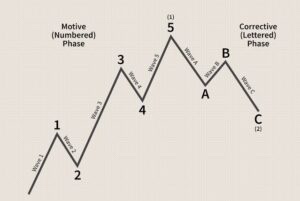Elliott Wave Theory is a popular technical analysis tool used by traders to forecast market trends and identify potential trading opportunities. The theory is based on the idea that markets move in predictable waves or cycles, which can be identified and analyzed using a series of patterns.

Here are the basics of Elliott Wave Theory:
- Wave Patterns: According to Elliott Wave Theory, market movements can be broken down into a series of waves, with each wave representing a specific phase of the market cycle. There are two types of waves: impulsive waves and corrective waves.
- Impulsive Waves: Impulsive waves are characterized by a strong move in the direction of the underlying trend. These waves are made up of five smaller waves and are labeled 1, 2, 3, 4, and 5.
- Corrective Waves: Corrective waves are characterized by a move against the underlying trend. These waves are made up of three smaller waves and are labeled A, B, and C.
- Fibonacci Ratios: Elliott Wave Theory makes use of Fibonacci ratios to identify potential reversal points in the market. These ratios are based on the mathematical sequence discovered by the Italian mathematician Leonardo Fibonacci.
- Wave Count: To apply Elliott Wave Theory, traders need to identify the current wave count in the market. This involves analyzing the price movements on a chart and identifying the waves and sub-waves that make up the market cycle.
- Wave Degree: The degree of the wave refers to the size and significance of the wave in relation to the overall market cycle. There are different degrees of waves, ranging from Grand Supercycle to Subminuette.
- Wave Extensions: In some cases, waves may extend beyond the normal length, indicating a strong trend in the market. These are known as wave extensions and can be used to identify potential trading opportunities.
In summary, Elliott Wave Theory is a complex technical analysis tool that involves identifying wave patterns, using Fibonacci ratios, and analyzing the degree and extensions of waves to forecast market trends and identify potential trading opportunities. It requires a good understanding of market cycles and technical analysis, and traders should be cautious when using it to make trading decisions.